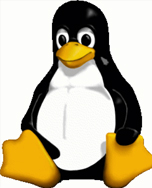
“ Tux” the
Linux Penguin
is the unofficial
mascot of Open
Source.
|
In order to understand
the concept and philosophies
behind Linux, open source
and retail software like
that marketed by Microsoft
and other similar software
publishers, one need
not be a technical guru.
Simply put a computer
software package is like
a symphony; it is the
result of a team effort
guided by a score of
notes written as sheet
music. When enjoying
a symphony most of the
audience has no idea
what the sheet music
looks like, they simply
enjoy the final product,
the music.
Computer software too
has a sort of “sheet
music.” Programmers
write software in “code.” Code
or “source code” is
the human-readable instructions
that are fed into the
computer to create a
program. Looking
in the “view” menu
of a Web browser you
will see “View
Source” or simply “Source.” Clicking
there reveals the code
of the World Wide Web
called HTML. All
Web sites allow open
access to the underlying
source code that creates
them. For those
learning about HTML programming
this can be a valuable
tool aiding in the understanding
of how the Web works.
Getting back to the
symphony analogy: like
sheet music the source
code is given to the
computer’s “compiler” which
turns the human-readable
code into “machine
language,” a series
of 1’s and 0’s
that the computer’s
processor (electronic
brain) can understand. Like
feeding sheet music to
the orchestra performing
a symphony, the source
code allows the computer
to perform for the user.
All of the programs
on your computer are
made from source code. Just
as one doesn’t
need to see sheet music
to enjoy a concert, most
computer users will never
see source code in the
course of using their
computers. And
the average user does
not miss it. For
other users more versed
in programming, especially
in business applications,
viewing and changing
source code directly
is a major benefit.
For example: imagine
that you are in charge
of flight operations
for a major airline. As
security is heightened
after Sept. 11, you are
asked to keep closer
track of baggage by linking
each checked item with
a passenger’s driver’s
license or ID number. Your
current computer reservation
system does not allow
for this operation. If
the reservation software
is open source you may
be able to hire a programmer
to integrate this new
feature by editing the
source code and recompiling
it.
The difference between
open source and products
like those of Microsoft
is that Microsoft’s
products are distributed
without the source code. Microsoft’s
code remains a proprietary
secret. Microsoft
and other commercial
software vendors use
this technique to keep
control of the software. If
Microsoft were the software
vendor in the hypothetical
airline software situation
you would be required
to purchase an upgrade
to add the additional
tracking functionality
or, if Microsoft did
not offer an upgrade,
you would be forced switch
to another software package
that did. |

















